>
Eupercaria/misc (Various families in series Eupercaria) >
Lutjanidae (Snappers) > Lutjaninae
Etymology: Lutjanus: Malay, ikan lutjan, name of a fish.
More on authors: Quoy & Gaimard.
Environment: milieu / climate zone / depth range / distribution range
Ökologie
seewasser riff-verbunden; tiefenbereich 0 - 36 m (Ref. 9710). Tropical; 20°N - 26°S, 118°E - 146°W (Ref. 55)
Western Pacific: mainly southern Oceania from Tahiti to New Guinea, and extending northward to the Philippines. Uncommon except in the Caroline Islands (Ref. 9710).
Size / Gewicht / Alter
Maturity: Lm ? range ? - ? cm
Max length : 35.0 cm TL Männchen/unbestimmt; (Ref. 55); common length : 20.0 cm TL Männchen/unbestimmt; (Ref. 55)
Rückenflossenstacheln (insgesamt): 10; Rückenflossenweichstrahlen (insgesamt): 13; Afterflossenstacheln 3; Afterflossenweichstrahlen: 8 - 9. Dorsal profile of head moderately sloped. Preorbital width about equal to eye diameter or slightly greater. Preopercular notch and knob poorly developed. Scale rows on back rising obliquely above lateral line. Generally pink, grading to white on lower half of the body. A series of seven narrow brown bars extend from the back to about half way down the side. A big black blotch is on the peduncle and the adjacent caudal-fin base (Ref. 469). Body depth 2.6-3.1 in SL (Ref. 90102).
Adults inhabit coral reefs where it usually occurs singly or in small groups. A shy species that moves around quickly through coral channels in hunt for small fishes (Ref. 48635). Minimum depth reported taken from Ref. 128797.
Life cycle and mating behavior
Geschlechtsreife | Fortpflanzung | Ablaichen | Eier | Fecundity | Larven
Allen, G.R., 1985. FAO Species Catalogue. Vol. 6. Snappers of the world. An annotated and illustrated catalogue of lutjanid species known to date. FAO Fish. Synop. 125(6):208 p. Rome: FAO. (Ref. 55)
IUCN Rote Liste Status (Ref. 130435)
Bedrohung für Menschen
Harmless
Nutzung durch Menschen
Fischereien: weniger kommerziell
Mehr Information
NamenSynonymeMetabolismusRäuberÖkotoxikologieFortpflanzungGeschlechtsreifeAblaichenSpawning aggregationFecundityEierEientwicklung
ReferenzenAquakulturAquakultur ProfilZuchtlinienGenetikElectrophoresesVererbbarkeitKrankheitenVerarbeitungNutrientsMass conversion
PartnerBilderStamps, Coins Misc.LauteCiguateraGeschwindigkeitSchwimmstilKiemenoberflächeOtolithsGehirngrößeSehfähigkeit
Tools
Zusatzinformationen
Download XML
Internet Quellen
Estimates based on models
Preferred temperature (Ref.
123201): 26.4 - 28.9, mean 28 °C (based on 154 cells).
Phylogenetic diversity index (Ref.
82804): PD
50 = 0.5000 [Uniqueness, from 0.5 = low to 2.0 = high].
Bayesian length-weight: a=0.01288 (0.00736 - 0.02254), b=3.03 (2.89 - 3.17), in cm total length, based on LWR estimates for this species & Genus-body shape (Ref.
93245).
Trophic level (Ref.
69278): 4.1 ±0.68 se; based on food items.
Widerstandsfähigkeit (Ref.
120179): mittel, Verdopplung der Population dauert 1,4 - 4,4 Jahre. (Preliminary K or Fecundity.).
Fishing Vulnerability (Ref.
59153): Low vulnerability (25 of 100).
Nutrients (Ref.
124155): Calcium = 54.2 [34.7, 83.9] mg/100g; Iron = 0.448 [0.259, 0.707] mg/100g; Protein = 18.8 [17.2, 20.2] %; Omega3 = 0.14 [0.09, 0.21] g/100g; Selenium = 61.1 [37.1, 100.0] μg/100g; VitaminA = 106 [19, 417] μg/100g; Zinc = 0.481 [0.361, 0.707] mg/100g (wet weight);
